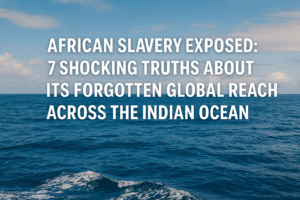African Slavery Exposed: 7 Shocking Truths About Its Forgotten Global Reach Across the Indian Ocean
The African slave trade extended far beyond the Atlantic, driven by diverse powers over centuries. Ethiopian rulers actively sold captives across the Red Sea to Arabia and India, where enslaved Africans, known as Sidis, rose to prominence—military leader Malik Ambar even earned his former Mughal enemy’s respect. Sidi communities ruled Indian states like Janjira for centuries, leaving cultural legacies persisting in 250,000 descendants today.
Oman dominated the brutal Indian Ocean trade, only abolishing slavery in 1970 after external pressure. Simultaneously, the Sokoto Caliphate enslaved millions within West Africa, rivaling the U.S. South’s pre-Civil War scale. North Africa’s Barbary states enslaved over a million Europeans alongside Africans trafficked by Ottomans, highlighting a vast, two-way human commerce. This interconnected, global exploitation underscores slavery’s monumental reach and lasting scars.

African Slavery Exposed: 7 Shocking Truths About Its Forgotten Global Reach Across the Indian Ocean
The narrative of African slavery is often dominated by the transatlantic trade. Yet, a deeper look reveals a sprawling, complex network of enslavement radiating far beyond the Atlantic shores, deeply involving African powers and reaching deep into Asia. The story of Ethiopia offers a powerful starting point.
Ethiopia: A Hub in a Global Network Ethiopian rulers weren’t just consumers of enslaved labor within their own courts; they were active participants in a Red Sea trade, selling captives into Arabia. This was merely one artery. Traders transported Ethiopians across the Indian Ocean to India, and evidence suggests some even reached China. The famed 14th-century traveler Ibn Battuta documented encountering thousands of Ethiopians during his journeys through India and Ceylon (Sri Lanka).
The Sidis of India: From Captives to Kings In India, enslaved Africans became known as Sidis. Mostly men, they integrated through marriage with local women, gradually becoming part of the subcontinent’s diverse tapestry. However, their impact was profound and lasting. Remarkable individuals like Malik Ambar, an Ethiopian-born military leader, rose to legendary status in the 17th century, fiercely resisting the mighty Mughal Empire. Emperor Jahangir himself, a former adversary, conceded in his memoirs that Ambar, though born a slave, possessed unparalleled abilities in warfare, command, judgement, and administration, achieving heights “History records no other instance of” for an Abyssinian slave.
Beyond individuals, Sidi communities established enduring political power. They ruled the states of Janjira (from 1618) in modern-day Maharashtra and Sachin (from 1791) in Gujarat, both maintaining autonomy until Indian independence in 1947. Janjira notably functioned as a hub for both enslaved and free African migrants, even employing democratic elections for its leaders. As late as 1851, traveler Richard Burton noted the distinct African character of people in Sindh.
Estimating the total number of enslaved people on the subcontinent is challenging, with figures ranging wildly from 6-8 million (cited in 1840) to 16 million (a later, broader estimate). Today, around 100,000 people in India and 150,000 in Pakistan still identify as Sidis. While a small minority, they preserve unique cultural legacies – elderly Sidis spoke Kiswahili well into the 20th century, and Swahili musical traditions, including distinctive drumming, persist. Sadly, Sidis in Pakistan face significant discrimination and racism.
The Indian Ocean Trade: Arabs, Europeans, and Omani Dominance The Indian Ocean slave trade was a massive, centuries-long enterprise where Arabs, Muslims, Swahilis, and later Europeans were major players. Calculations show that between 1500 and 1873:
- Arabs, Muslims, and Swahilis exported approximately 937,000 Africans.
- Europeans exported between 755,500 and 1,156,000 Africans.
Oman emerged as a dominant slaving power, predating Portuguese arrival. Its sultans even moved their capital to Zanzibar to exploit the lucrative trade in slaves, ivory, and cloves. This brutal commerce only ended under intense external pressure: the Royal Navy threatened bombardment in 1873 to force abolition in Zanzibar, and conflict with Belgians ensued in 1891. Shockingly, Oman itself didn’t formally abolish slavery within its own territory until 1970, a decade after Saudi Arabia.
The Sokoto Caliphate: An African Slave Society of Immense Scale Turning west, the Sokoto Caliphate (1804-1903) in what is now Nigeria stands as one of the largest slave societies in modern history. Slavery, deeply entrenched before its rise, became its economic and social “backbone” under jihadist expansion, primarily targeting Hausa communities. Historian Paul Lovejoy suggests the Caliphate may have held as many slaves as the United States on the eve of its Civil War (around 4 million), potentially exceeding numbers in Brazil or the Caribbean colonies at their peaks – likely exceeding 2 million and perhaps reaching 4.5 million.
The Ottoman Empire & Barbary States: A Two-Way Traffic Slavery extended north as well. The Ottoman Empire enslaved approximately 1,167,000 Africans across its domains. Simultaneously, the Barbary States (Ottoman dependencies in North Africa) conducted extensive raids on European coasts, enslaving at least 1,000,000 Europeans between the 16th and early 19th centuries. Algiers alone imported an estimated 625,000 Europeans between 1520 and 1830. These European captives faced brutal conditions – rowing in galleys, laboring in fields, or serving in households, including harems. This highlights the crucial, often overlooked fact: captives flowed both to and from the African continent.
The Echoes and the Reckoning This sprawling history underscores a profound reality: the enslavement of Africans was a global phenomenon, deeply interwoven with the economies, societies, and conflicts of powers across Africa, the Middle East, Asia, and Europe for centuries. The legacies persist – in the cultural resilience of the Sidis, in the demographic and social fabrics of regions from Arabia to India, and in the deep scars that fuel the ongoing, complex global reparations movement seeking acknowledgment and redress for these interconnected histories of exploitation. Remembering the sheer scale and geographic spread of this trade is essential to understanding the full depth of its impact.
You must be logged in to post a comment.